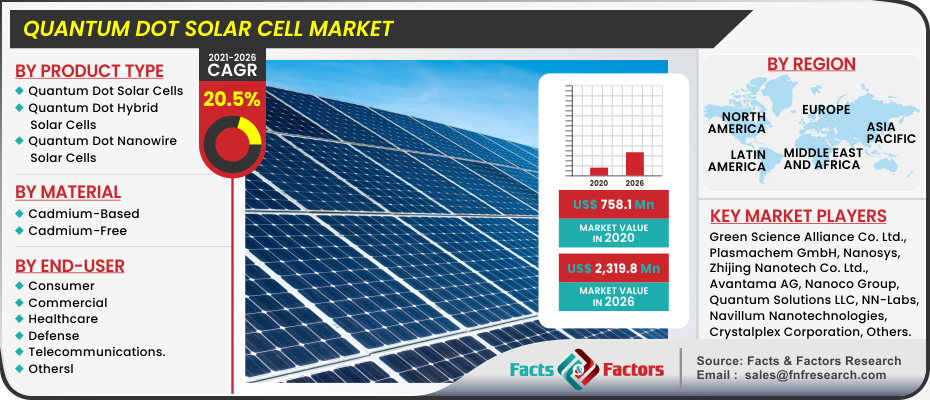Search Market Research Report
Quantum Dot Solar Cell Market Size, Share Global Analysis Report, 2021 – 2026

Quantum Dot Solar Cell Market by Product Type (Quantum Dot Solar Cells, Quantum Dot Hybrid Solar Cells, and Quantum Nanowire Solar Cells), By Material (Cadmium-Based and Cadmium-Free) and By End User (Consumer, Commercial, Healthcare, Defense, Telecommunications. and Others): Global and Regional Industry Perspective, Comprehensive Analysis, and Forecast 2021 – 2026
Industry Insights
[219+ Pages Report] According to a Facts and Factors report, the global quantum dot solar cells market was registered at approximately USD 758.1 Million in 2020 and is expected to generate revenue of almost USD 2,319.8 Million by the year 2026, growing at a CAGR of approximately 20.5% between 2021 and 2026.
 Market Overview
Market Overview
Quantum dots are thought to be man-made atoms. Their energy levels can be adjusted by changing their size, which defines the bandgap. The dots can be grown in a variety of sizes, allowing them to communicate a wide range of bandgaps without changing the underlying material or construction. Sizing is accomplished by varying the duration or temperature of the fusion.
Quantum dot solar cells have the potential for solar, or photovoltaic, cells that reduce wasteful heat while maximizing the amount of solar energy converted to electricity. This is significant in terms of making solar energy more cost-competitive with traditional power sources.

 Industry Growth Factors
Industry Growth Factors
In 2021, the multibillion-dollar quantum dot-enabled market will grow even more, with market innovations leading to improved products in displays, Micro-LEDs, security tagging, medical diagnostics, quantum computing, and Agtech.
QDs (Quantum Dot) are a proven and scaled technology that is relatively inexpensive for the high-end applications to which they add value. Quantum Dots (QDs) are used in a variety of optoelectronic devices, such as televisions and displays, light-emitting devices (LEDs), solar cells, photodiodes, thermoelectrics, photoconductors, and field-effect transistors, and QD solutions have been used in a variety of in vivo and in vitro imaging, sensing, and labeling techniques
 Segmentation Analysis
Segmentation Analysis
The global quantum dot solar cell market is segregated based on product type, end-user, material, and regions. Based on product type, the quantum dot solar cell market is categorized into quantum dot hybrid solar cells, quantum dot solar cells, and quantum dot nanowire solar cells. Cadmium-based and cadmium-free are the further bifurcation of the material segment. Cadmium-free quantum dots have the potential not only for displays but also for a wide range of other applications, including solar cells. In addition, the report also classified the end-user segment into consumer, healthcare, defense, commercial, telecommunications, and others
 Regional Analysis
Regional Analysis
In 2020, North America is expected to retain its supremacy in the global quantum dot solar cell market from a regional perspective. North America dominates the quantum dot solar cell market owing to the adoption of advanced technology in the U.S., and Canada. Moreover, the growing number of applications for quantum dot solar cells, such as chromatic windows and heat-resistant tiles, is also expected to fuel the market in this region. During the forecast period, Asia Pacific is expected to develop at the fastest CAGR. Customers' desire to embrace technically superior products, along with the increased research and development in QD technology by major display manufacturers, have fueled market expansion in this region. Furthermore, owing to the increased adoption of quantum dots-enabled products in consumer electronics, automotive, and healthcare is also anticipated to fuel market growth in the upcoming years.
 Report Scope
Report Scope
Report Attribute |
Details |
Market Size in 2020 |
USD 758.1 Million |
Projected Market Size in 2026 |
USD 2,319.8 Million |
Growth Rate |
CAGR 20.5% |
Base Year |
2020 |
Forecast Years |
2021-2026 |
Key Market Players |
Plasmachem GmbH, Zhijing Nanotech Co. Ltd., Samsung Electronics, Avantama AG, Quantum Solutions LLC, Crystalplex Corporation, Osram Licht, Nanoco Group, Green Science Alliance Co. Ltd., Nanosys, Navillum Nanotechnologies, NN-Labs, and Ocean NanoTech amongst others. |
Key Segment |
By Product Type, By Material, By End User, and By Region |
Major Regions Covered |
North America, Europe, Asia Pacific, Latin America, and the Middle East & Africa |
Purchase Options |
Request customized purchase options to meet your research needs. Explore purchase options |
 Competitive Players
Competitive Players
 Some main participants of the quantum dot solar cell market are
Some main participants of the quantum dot solar cell market are
- Green Science Alliance Co. Ltd.
- Plasmachem GmbH
- Zhijing Nanotech Co. Ltd.
- Avantama AG
- Quantum Solutions LLC
- Crystalplex Corporation
- Nanoco Group
- Nanosys
- Navillum Nanotechnologies
- NN-Labs
- Ocean NanoTech
- Osram Licht
- Samsung Electronics
 By Product Type:
By Product Type:
- Quantum Dot Solar Cells
- Quantum Dot Hybrid Solar Cells
- Quantum Dot Nanowire Solar Cells
 By Material:
By Material:
- Cadmium-Based
- Cadmium-Free
 By End-user:
By End-user:
- Consumer
- Commercial
- Healthcare
- Defense
- Telecommunications.
- Others
 By Region:
By Region:
- North America
- The U.S.
- Canada
- Europe
- France
- The UK
- Spain
- Germany
- Italy
- Rest of Europe
- Asia Pacific
- China
- Japan
- India
- South Korea
- Southeast Asia
- Rest of Asia Pacific
- Latin America
- Brazil
- Mexico
- Rest of Latin America
- Middle East & Africa
- GCC
- South Africa
- Rest of Middle East & Africa
Industry Major Market Players
- Green Science Alliance Co. Ltd.
- Plasmachem GmbH
- Zhijing Nanotech Co. Ltd.
- Avantama AG
- Quantum Solutions LLC
- Crystalplex Corporation
- Nanoco Group
- Nanosys
- Navillum Nanotechnologies
- NN-Labs
- Ocean NanoTech
- Osram Licht
- Samsung Electronics

Copyright © 2024 - 2025, All Rights Reserved, Facts and Factors


